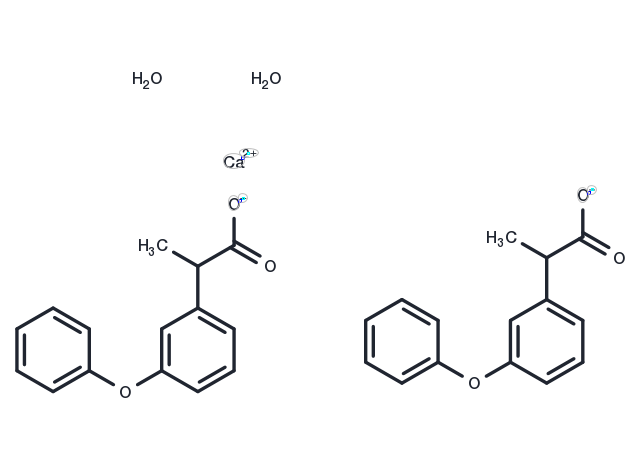Powder: -20°C for 3 years | In solvent: -80°C for 1 year


Fenoprofen calcium hydrate (Progesic dihydrate) is a non-steroidal anti-inflammatory drug (NSAID).

| Pack Size | Availability | Price/USD | Quantity |
|---|---|---|---|
| 1 g | In stock | $ 50.00 | |
| 1 mL * 10 mM (in DMSO) | In stock | $ 50.00 |


| Description | Fenoprofen calcium hydrate (Progesic dihydrate) is a non-steroidal anti-inflammatory drug (NSAID). |
| In vitro | Fenoprofen is a more potent inhibitor of collagen-induced platelet aggregation than either aspirin or phenylbutazone. [1] Fenoprofen inhibits the formation of palmitoyl-CoA in both microsomal and peroxisomal fractions, and inhibits the beta-oxidation of lignoceric acid and cerotic acid in rat hepatocytes. [5] Fenoprofen exhibits modest antiproliferative activity against HT-29, DID-1, and SW480 cells with IC50 of 240 μM, 300 μM, and 360 μM, respectively. [6] Fenoprofen (0.1 mM) is an efficient activator of peroxisome proliferator-activated receptor gamma (PPARγ), activating the receptor to a degree comparable to that obtained with the PPARγ ligands BRL49653 and 15-deoxy-D12,14-PGJ2 and the peroxisome proliferator Wy14643. Fenoprofen is also an efficacious activator of PPARα, activating the receptor to a degree comparable to that obtained with the strong peroxisome proliferator Wy14643. Consistently, Fenoprofen treatment promotes lipogenesis in C3H10T1/2 cells. [7] Although Fenoprofen displays only modest antiproliferative activity, Fenoprofen amides can potently induce cell cycle arrest at the G1 phase, as well as apoptosis, probably because of a greater lipophilicity and/or better cell uptake. [9] |
| In vivo | Oral administration of Fenoprofen at 50 mg/kg potently inhibits thrombus formation by 47%, whereas a dose of 200 mg/kg of aspirin is required to reduce thrombus formation 21 %. [1] Similar to indomethacin, adminstration of Fenoprofen inhibits prostaglandin synthesis. [2] In rats with type II collagen-induced arthritis, Fenoprofen treatment at 40 mg/kg/day partially suppresses the paw swelling, but has no significant effect on humoral and cellular responses. [3] Administration of Fenoprofen depresses the rebound contraction, thus transforming the brisk relaxant response, elicited by vagal stimulation or ATP, into long-lasting relaxation. [4] Administration of Fenoprofen causes a strong and dose-related induction of peroxisomal palmitoyl-CoA oxidase, and of carnitine acyltransferase and acyl-CoA hydrolase activities in liver homogenates of mice fed diets. Hepatic catalase activity is significantly increased in mice fed the diet with 0.05 and 0.1% fenoprofen but not the 1% fenoprofen-containing diet. [8] |
| Cell Research | Cells are exposed to various concentrations of Fenoprofen for 6 days. Cell number is determined using the SRB colonimetnic protein stain assay. After 6 days of culture, cells are fixed by the addition of cold trichloroacetic acid to a final concentration of 10%. Plates are incubated at 4 °C for 1 hour, then the supernatant is aspirated and the plates are washed with deionized water. SRB solution is formulated to 0.4% w/v in 1% acetic acid; 100 μL is added to each well and the plates are incubated for 10 minutes at room temperature. Unbound SRB is removed by washing with 1% acetic acid followed by air drying. Bound stain is solubilized with 50 mM unbuffered Tris and absorbance is read by an automated spectrophotometer at a single wavelength of 540 nm.(Only for Reference) |
| Synonyms | Feprona dihydrate, Fenoprofen calcium salt dihydrate, Progesic dihydrate |
| Molecular Weight | 558.63 |
| Formula | C15H14O3·1/2Ca·H2O |
| CAS No. | 71720-56-4 |
Powder: -20°C for 3 years | In solvent: -80°C for 1 year
Ethanol: 15 mg/mL (19.1 mM)
DMSO: 45 mg/mL (57.3 mM)
H2O: < 1 mg/mL (insoluble or slightly soluble)
You can also refer to dose conversion for different animals. More
bottom
Please see Inhibitor Handling Instructions for more frequently ask questions. Topics include: how to prepare stock solutions, how to store products, and cautions on cell-based assays & animal experiments, etc.
Fenoprofen calcium hydrate 71720-56-4 Apoptosis Immunology/Inflammation Neuroscience Others COX Feprona Dihydrate Feprona dihydrate Cyclooxygenase Fenoprofen calcium salt dihydrate inhibit Fenoprofen calcium Hydrate Progesic dihydrate Progesic Dihydrate 53746-45-5 Fenoprofen Calcium Inhibitor Progesic Fenoprofen calcium Feprona Fenoprofen calcium Dihydrate inhibitor
